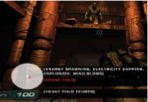Games like DOOM(CC) can describe in-game sounds for hearing-impaired gamers.
WHILE MIXING GAMES, WE AUDIO professionals often take great strides to ensure that a player with a basic listening environment will have as rewarding an audio experience as someone with a fully tricked-out surround sound home theater would. Unfortunately, we tend to make one major assumption with this approach and—whether consciously or not—ignore the inherent frailties of the human body.
At best estimates, there are approximately three million Americans between the age range of 3–34 that are either deaf or hard of hearing. This covers anyone from those who can understand shouted speech to those who are completely deaf. At the dawn of PC and console game development, technological limitations actually went a long way toward fostering an inclusive era of game accessibility (GA) for all. Actions, dialog, and game mechanics were frequently text- driven events. As disc space increased and game technology improved, text was replaced with recorded dialogue or sound effects. Unfortunately, hearing- impaired gamers quickly found themselves losing many of the gameplay conventions they had come to count on for relaying critical information.
LOOK AND LISTEN
One of the easiest solutions to the problem of visually representing sound in next-gen software is the inclusion of closed captioned text in-game. The concept of closed captions is borrowed from the world of television, and is manifest as lines of text on screen, which represent any dialog, sound, or music that has been programmed to appear. Most common is the practice of captioning cutscene or in-game dialog. However, any sound that can be described can be captioned. Additionally, closed captions can be color-coded in order to aid in the clear demarcation of player sounds versus environmental sounds, for example.
Unfortunately, very few games are completely captioned. Only four commercially released games have included a full closed captioning system, the most widely known of which is HALF- LIFE 2. However, the GA community is a very active one and mod projects exist to expand the number of captioned games. In 2006, the IGF nominated Games[CC]’s DOOM3[CC] for best DOOM mod of the year.
Text isn’t the only way to represent sound, however. In addition to closed captioning, various other feedback systems can be built into the game to approximate, augment, or substitute for audio in ways that benefit hearing players as well. Cartoon-y visualized hit impacts such as those found in games like ALIEN HOMINID and VIEWTIFUL JOE add to the games’ art styles while offering a silent way to know that weapon fire connected with an enemy target. In-game icons and radar like those used in the METAL GEAR SOLID franchise convey changes in enemy AI threat states just as effectively as their accompanying alert sounds or changes to the interactive music score. Blinking HUD elements such as low health or ammo are a common component to first person shooters that are often accompanied by beeping auditory feedback. Even the use of a console controller’s rumble feature can be used to express any number of audio elements from explosions to lock picking to an overheating engine.
SOUND IT OUT
At the other end of the audio experience spectrum, there are visually impaired gamers. Approximately four million Americans between the same consumer age range are blind or visually-impaired. For visually impaired gamers, an entire cottage industry of “audio-only” GA games has sprung up to meet their needs, the vast majority of which can be found at AudioGames.net.
Audio games are devoid of any graphic representation and convey all gameplay information through a diverse range of auditory feedback. Weapons, UI options, character locomotion, inventory statistics, and relative position within the game world are just a few of the traditionally visual pieces of game data represented strictly through audio. Additionally, audio games span the full gamut of genres ranging from puzzle games to racing games to third-person action games such as Studio Hunty’s IN THE PIT.
Spend some time with audio games and you’ll notice a number of conventions which can be applied to all game development. Perhaps the most important is how critical spatial sound becomes when a game lacks visuals. Many audio games rely on the placement of objects within a stereo or surround sound field as a major design element to the gameplay. Abstract and esoteric sounds, especially within the UI, hurt the gameplay experience. Contrarily, individualized and consistent sounds—such as barrel explosions or differentiated enemy hit impacts—serve as auditory anchor points that define in-game actions, aid in perception, and provide immediately recognizable feedback to the player.
GAMES FOR ALL
It’s important to keep in mind that game accessibility isn’t strictly about contributing to the gaming experience of disabled gamers. As Reid Kimball, creator of the DOOM3[CC] mod and a colleague of mine at LucasArts, states, “GA equals ‘games for all,’ in my opinion,” and that’s a sentiment commonly found throughout the GA community. Closed captions can help younger children learn to read, clarify foreign language or heavily accented dialog, and add an additional important piece of gameplay feedback for a richly immersive environment. For designers, audio-only gameplay represents a largely unexplored area of game design.

